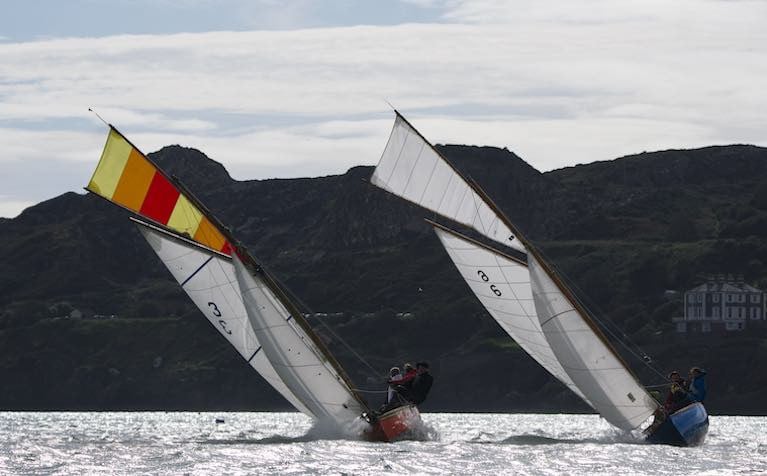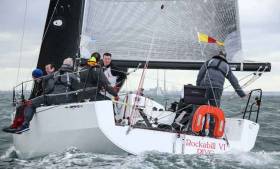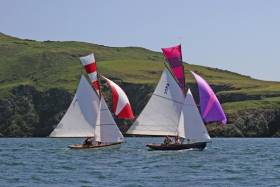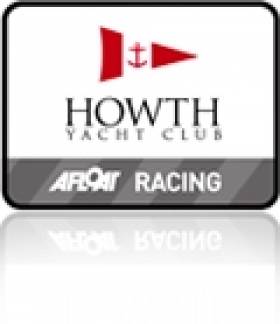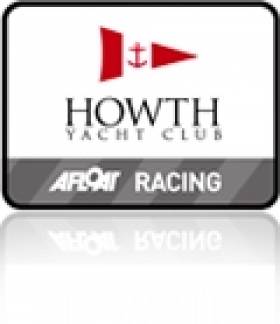Displaying items by tag: Lambay race
Howth Yacht Club's Historic Lambay Race Attracts 78 Keelboats Despite Club-Only Format
With official club racing only permissible since last Monday, June 7th, and many fit-out schedules delayed through May's atrocious weather, the realists had been hoping for a turnout of maybe around 40 boats for Howth YC's opening major event of this "make it up as you go along" 2021 season, the time-honoured annual Lambay Race on Saturday which was further restricted in numbers by being billed as a club-only event.
Yet a little miracle took place at the Fingal peninsular port. The weather became summery as the week went on, the mood improved with it, and with the inspiration of five of the venerable Howth 17s staging the club's first "official" race for some time at 10:30hrs on Bank Holiday Monday June 7th, clearly it behoved anything which moved and floated and set sails to get out there and celebrate with the Lambay circuit.
 The Howth 17s mustered 12 boats and found a flash of sunshine for their start, with Peter Courtney's Oonagh (17) and the Turvey brothers' Isobel getting the best of it at the far end of the line. Photo: Annraoi Blaney
The Howth 17s mustered 12 boats and found a flash of sunshine for their start, with Peter Courtney's Oonagh (17) and the Turvey brothers' Isobel getting the best of it at the far end of the line. Photo: Annraoi Blaney
 Orla and Isobel crossing tacks north of Lambay. Photo: Annraoi Blaney
Orla and Isobel crossing tacks north of Lambay. Photo: Annraoi Blaney
This was only slightly hampered by the wind managing to blow from every direction between southeast and west during the course of the race, while – apart from the occasional flash of brightness – the sun stayed behind cloud until most of the racing was over. But at least there nearly always was wind, and it was a warm breeze at that, making the intricacies of getting round the island – in addition to many other set course challenges – a gentle business even when you were making to wind.
 IRC 2 on the wind with Half Tonners King One and Mata trying to find their way past the X302 Xebec. A long time ago, King One was Half Ton World Champion in the ownership of four times Olympic Gold Medallist Paul Elvstrom of Denmark, and now - as part of the Kelly stable - she was class winner round Lambay. Photo: Annraoi Blaney.
IRC 2 on the wind with Half Tonners King One and Mata trying to find their way past the X302 Xebec. A long time ago, King One was Half Ton World Champion in the ownership of four times Olympic Gold Medallist Paul Elvstrom of Denmark, and now - as part of the Kelly stable - she was class winner round Lambay. Photo: Annraoi Blaney.
Not surprisingly, the largest single turnout – 19 boats – was in the non-spinnaker class, where some cruising boats which hadn't raced in years were caught up in the mood of the moment to display amazingly sharp performances.
Among the One-Design Classes, the Puppeteer 22s had shaken off enough of the cobwebs to have a turnout of 13, with the Howth 17s next in line with the round dozen, while the three hot IRC Classes all mustered good quorums with a set of results which will keep the directors of J Boats Europe purring with content.
 The Half Tonner Mata (Wright brothers & Rick DeNeve). If you want to do well in the Lambay Race, exclude all marine ornithologists from your crew, as their concentration will al most immediately be elsewhere. Photo: Annraoi Blaney
The Half Tonner Mata (Wright brothers & Rick DeNeve). If you want to do well in the Lambay Race, exclude all marine ornithologists from your crew, as their concentration will al most immediately be elsewhere. Photo: Annraoi Blaney
The Half Tonner Mata (Wright brothers & Rick DeNeve). If you want to do well in the Lambay Race, exclude all marine ornithologists from your crew, as their concentration will al most immediately be elsewhere. Photo: Annraoi Blaney
All the results are here in detail, while the headline placing were:
- White Sail HPH: 1st Zarquon (M & J Wenski) 2:33:16; 2nd Spellbound (Burrows/Skeffington) 2:38:13; 3rd Blue Extra (M. Carroll) 2:20:46.
- White Sails IRC 1st Bite the Bullet (Elan 333, Colm Bermingham) 2:31:37; 2nd Toughnut (MG 34, D Skehan) 2:36:46; 3rd Spellbound (Burrows/Skeffington) 2:38:33
- IRC 1: 1st Lambay Rules (J/97, S Quinn), 2:59:10; 2nd Snapshot (J/99, M & R Evan, J/99) 2:59:31; 3rd Outrajeous (J/109, R Colwell & J Murphy) 3:01:48.
- IRC 2: 1st King One (Elvstrom Half Tonner, D.Kelly) 2.55.27; 2nd Mata (Classic Half Tonnner, Wright bros & R DeNeve) 2:56:12; 3rd Checkmate XV (Humphreys Half Tonner, D Cullen) 2.59:17
- IRC 3: 1st Legal Alien (Sommerville & Kavanagh) 2:39:44; 2nd Insider (S & D Mullaney, Sigma 33) 2:39:39; 3rd Animal (G O'Sullivan, Formula 28) 2:40:23
- J/80: 1st Jeannie (R Dix, 3:15:04; 2nd Red Cloud (N Reilly) 3:16:22; 3rd Jammy (D O'Grady, 3:16:50
- Howth 17: 1st Deilginis (Massey/Toomey/Kenny) 3:47:17 2nd Aura (I Malcolm) 3:48:52; 3rd Anita (D Massey) 3:51:36
- Puppeteer 22: 1st Gold Dust (Walls/Brown) 3:26:35; 2nd Trick or Treat (A Pearson & A Blay) 3:28:35; 3rd Yellow Peril (N Murphy & C Costello) 3:31:46
- Squibs: 1st Crackertoo (S Kay) 3:42:04; 2nd 3point9 (F O'Kelly) 3:42:57; 3rd Tears for Fears (N Monks) 3:45:19.
The Lambay Lady Trophy goes to the boat with the biggest margin between her first place and the next in class, and initial assessments suggest that Colm Bermingham's Elan 333 Bite the Bullet (White Sails IRC) wins it by 11 seconds from Zarquon (M & J Wenski), but some classes using the Orthodox Coptic PH system may yet come up with a larger margin.
 Storm is back in town……the Kelly family's successful J/109 Storm getting back in racing trim, with the unmistakable and unemployed Ringsend smokestacks very visible across the Sutton isthmus. When the stacks were first built in 1974, everybody objected to "these eyesores". Now that they're redundant and the powers-that-be expect to take them down, everybody is objecting to the "wanton destruction of these much-loved landmarks". Photo: Annraoi Blaney
Storm is back in town……the Kelly family's successful J/109 Storm getting back in racing trim, with the unmistakable and unemployed Ringsend smokestacks very visible across the Sutton isthmus. When the stacks were first built in 1974, everybody objected to "these eyesores". Now that they're redundant and the powers-that-be expect to take them down, everybody is objecting to the "wanton destruction of these much-loved landmarks". Photo: Annraoi Blaney
Howth’s Time-Honoured Lambay Race to be Staged as Club-Only Event on Saturday, June 12th
Under the current lockdown-easing programme, Saturday, June 12th will mark the first weekend when full-scale in-club officially sanctioned races will be possible. The latest word on the waterfront is that last night (Monday), the monthly meeting of Howth Yacht Club’s General Committee gave their support to the HYC Sailing Committee’s proposal of last Friday, suggesting that the Club stage its traditional weekend Lambay Race just as soon as legally possible, which is Saturday, June 12th. The oldest Lambay trophy dates back to 1899, but the earliest record of the race actually taking place is 1904, which still gives it special antiquity, such that racing round Lambay at least once a year is seen as integral to a proper Howth sailing season.
Howth Harbour
Meanwhile, Howth Harbour has been springing back to tentative life. There are two days in the year when the Harbour will see at least three cranes in action transferring boat between land in seas. The two standing cranes at the Howth YC marina are available on a year-round basis, though usually, only the main one is in frequent use. But on two set days in Spring and Autumn, the Howth Boat Club fleet - which lays up ashore at the lighthouse end of the East Pier, where the club has its HQ in the former Howth Sailing Club premises - becomes the peak focus of activity.
 Howth YC training session Oppies get round-the-mooring-buoys slalom action while the Howth Boat Club fleet - berthed end-on to the East Pier beyond - moves steadily towards full numbers. Photo: HYC
Howth YC training session Oppies get round-the-mooring-buoys slalom action while the Howth Boat Club fleet - berthed end-on to the East Pier beyond - moves steadily towards full numbers. Photo: HYC
HBC members recently organised upwards of two dozen of their fleet to get splashed in one neatly co-ordinated programme with a hire crane. But as most of them have their berths end-on to the East Pier, the newly re-commissioned moorings in the Outer Harbour will remain unoccupied for a while as people get used to the idea that the officially-sanctioned sailing season is only weeks away. In last weekend’s stronger winds, the HYC training fleets - mainly in Laser 470s and Optimists - found space for plenty of action in the Outer Harbour’s convenient shelter, with the mooring buoys giving extra options for slalom manoeuvres. And all the signs are that training fleets are going to increase in size until “Freedom Day” on Monday, June 9th releases everyone into the world of full-blown racing action.
 Action stations - the fleet is growing for HYC’s junior Laser training. Photo: HYC
Action stations - the fleet is growing for HYC’s junior Laser training. Photo: HYC
"Olympic Nightmare Course" Gives Howth 17 Lambay Sailors a Dream Race
The Olympic sailing dream is of competition on a sterile racing area with weak to non-existent tides, well clear of any special wind effects that a nearby coastline and an island or two might provide, while of course using a meticulously-set Committee Boat start line and a cleverly-designed course to test several points of sailing. That's the way they want it. Yet if that's their dream - their perfect ideal - then Howth Yacht Club's traditional sixteen nautical miles of Lambay Race must be Olympic sailing's stuff of nightmares.
The original Lambay Course – raced at least since 1904, and probably earlier - was simply though Howth Sound inside Ireland's Eye after a pier start from Howth Harbour, then nor' eastwards to the east point of Lambay. Officially, it's The Nose, but few remember to call it that, they just call it the East Point, as we've a Nose of Howth already, and that's quite enough to smell the coffee on any one day.
 Sixteen miles of sailing perfection – the classic Lambay course can serve up all sorts of conditions, but on Saturday it provided record times
Sixteen miles of sailing perfection – the classic Lambay course can serve up all sorts of conditions, but on Saturday it provided record times
The north side of Lambay seems like the Far Side of the Moon for most sailors, even those from Howth which is only seven miles away. And as you head west to double the island, there are various impairments to ease of navigation, such as Carrickdorish Rock and Harp Ear.
These are matters of even more concentration if you're beating against a westerly. But concentrating purely on sailing along there is difficult anyway, as Lambay is a natural wonder where the abundant wildlife - some of it on surprisingly spectacular cliffs - is augmented by a troupe of wallabies (don't ask), and Ireland's only colony of black rats, a cute little fellow who nevertheless would make life difficult for your average gannet settlement.
 Getting going for record times – Leila and Zaida (Tom Houlihan) with freed sheets, on course with a fair tide with Ireland's Eye put astern. Photo: Annroi Blaney
Getting going for record times – Leila and Zaida (Tom Houlihan) with freed sheets, on course with a fair tide with Ireland's Eye put astern. Photo: Annroi Blaney
However, the Fingal gannet seems a tougher proposition than those from elsewhere. Having established his first neighbourhood colony on the Stack at Ireland's Eye back in 1989, when that got crowded his descendants and relatives not only started spreading onto the main island itself regardless of its predators, but they set up an offshoot on a big rock close under the cliffs on the other side of Lambay six miles to the north.
That has prospered so much that they appear to have bludgeoned their way onto Lambay itself through being the Neighbours from Hell for poor little rattus rattus, who is now on the endangered species list. As for the wallabies, they can't be too pleased, as they used to top the Lambay attractions chart until these rock-star gannets came along.
Brian Maguire of Hyberno Droneworks follows the fleet.
All these interesting things are going on along the Far Side of the Moon, aka the north side of Lambay, making it difficult to think only of sailing - let alone racing tactics - in a locality notorious for its flukey winds and tricky tides. As a result, when the Lambay Race is on the agenda, the Howth sailing community is a bit thin on the community spirit, as the Single-minded Racing Purists think it's a very dodgy proposition in the first place, whereas the Broad-minded Historically-Concerned Philosophers think it's central to the very ethos of Howth sailing, an event which must be sailed in its traditional form each year as an Act of Worship .
 Rita (John Curley & Marcus Lynch) was first to Lambay, but was halfway down the fleet in the final reckoning. Photo: W M Nixon
Rita (John Curley & Marcus Lynch) was first to Lambay, but was halfway down the fleet in the final reckoning. Photo: W M Nixon
With such contrary opinions, the Lambay Race race has sometimes been messed about over the years, with extra marks being added to make it look more like a modern course. But in the difficulties of our current situation, the 1898-founded Howth Seventeens saw an opportunity. They wanted to celebrate getting a dozen boats of their ancient 20-strong fleet finally afloat despite 2020's truncations, and the best way seemed to be a race the traditional straightforward 16-mile Lambay Course on Saturday 5th September, as the tides suited – flood going north and favourable ebb coming back - and they could do it as their own thing, without trying to make an all-comers regatta out of it.
 The dark side? Gladys, owned by HYC Commodore Ian Byrne and Eddie Ferris, finds a bright spot on the north side of Lambay. Photo: W M Nixon
The dark side? Gladys, owned by HYC Commodore Ian Byrne and Eddie Ferris, finds a bright spot on the north side of Lambay. Photo: W M Nixon
It made for a busy day at Howth in the day's brisk westerly, as a race of the Fingal Series for cruiser-racers went off around 1000 hrs, the Howth 17s buzzed northwards towards Lambay – just able to carry their topsails – in a starting sequence beginning at 1130 hrs, and then towards 1430 hrs as the Puppeteer 22s and the Squibs were squaring up for their weekly Saturday afternoon race, didn't the Howth 17s come roaring back down the Sound again with the full ebb under them after probably the fastest Lambay Race the class has ever recorded.
Yet far from being left on their own to get on with it, in this most peculiar sailing season they'd had an escort fleet dominated by the local flotilla of dark blue Seaward 23s and 25s carrying various photographers and a film team from TG4. For the word had got out that in this bleak year, a dozen Seventeens racing round Lambay would be a sight to cheer anyone up. And it was vintage stuff throughout, with real power to the dense-air wind at times, and flashes of vivid sunlight interspersed with curiously rain-free passing clouds, one or two so black they had the look of The End of Days about them.
 Close encounter. Rosemary (12) and Pauline in classic juxtaposition at the Taylor's Rocks buoy. In March 2018, Rosemary had become the "flatpack boat" after her shed was smashed in during Storm Emma, while Pauline was almost lost in a fire. Yet in 2020 they're both fighting fit again, with Pauline winning the close-fought 2020 Nationals. Photo: W M Nixon
Close encounter. Rosemary (12) and Pauline in classic juxtaposition at the Taylor's Rocks buoy. In March 2018, Rosemary had become the "flatpack boat" after her shed was smashed in during Storm Emma, while Pauline was almost lost in a fire. Yet in 2020 they're both fighting fit again, with Pauline winning the close-fought 2020 Nationals. Photo: W M Nixon
But for connoisseurs of Howth Seventeen sailing and the wonders of the Fingal coast, it was pure magic throughout. After an extremely fast and wet reach northward, appropriately it was the granny of them all, Howth 17 No 1 Rita (John Curley & Marcus Lynch) which was first at Lambay. But the wind flattened almost completely at the Nose such that the eight leading boat concertinaed into a straight line abreast, and first out of the traps in a private breeze which took them very close to Carrickdorish were the Massey/Toomey/Kenny syndicate in Deilginis with Keith Kenny on the helm, and Dave Mulligan with Sheila.
 The going is good. Deilginis has taken the lead, and found her own flash of sunshine with it. Photo: W M Nixon
The going is good. Deilginis has taken the lead, and found her own flash of sunshine with it. Photo: W M Nixon
Thereafter, Deilginis played it very cool on the short but position-setting beat along the north coast on Lambay, not getting too far offshore where there was a boat-stopping sea running and the tides were all over the place, yet not getting too far into the alluringly smooth water inshore, where the wind might suddenly disappear completely.
They were first to reach the most northerly turn at the buoy marking Taylor's Rocks off Lambay's northwest corner, and had quite a decent gap on Sheila. But Dave Mulligan had to put in a virtuoso performance on the long reach back to Howth, as the pack were right on his tail.
 The chasing pack are (left to right) Pauline, Sheila and Rosemary. Overall, they finished Sheila 2nd, Pauline 3rd and Rosemary 4th. Photo: W M Nixon
The chasing pack are (left to right) Pauline, Sheila and Rosemary. Overall, they finished Sheila 2nd, Pauline 3rd and Rosemary 4th. Photo: W M Nixon
As it turned out, they were having enough in-fighting to let him build his lead a bit, but there was no way he could make any dent on the gap to the flying Deilginis, which was literally racing against time as her topsail – which had been setting perfectly on port tack heading north – was all over the place on starboard tack heading south, though enough of it stayed working for her crew to claim they'd been deploying a clever topsail-scandalising trick to de-power the sailplan in the stronger gusts.
 With Lambay astern and the wind temporarily softening, Deilginis continues to maintain her lead on Sheila. Photo: W M Nixon
With Lambay astern and the wind temporarily softening, Deilginis continues to maintain her lead on Sheila. Photo: W M Nixon
Whatever, they maintained their lead to finish in two hours 36 minutes and 14 seconds, which may well be a Howth 17 Lambay record. And as they tacked onto port to get into the harbour, lo and behold but wasn't the topsail suddenly setting perfectly again…..Sheila was just over a minute astern, then came 2020 champion Pauline (Shane O'Doherty, Ian McCormick and Michael Kenny) and Rosemary (George Curley, David Jones & David Potter, with the four leaders finishing within two minutes.
On handicap (a very import element in the continuing strength of the class) the winner was Echo (Bryan & Harriet Lynch) from Tom Houlihan's Zaida, with Sheila and Pauline re-appearing in the listings at 3rd and 4th. In a more complete season, it would be hoped that there would seldom be much overlap between scratch and handicap.
 Deilginis storming home to win, with Portmarnock's Velvet Strand and the Pormarnock Hotel in the background. When Deilginis was being built by James Kelly of Portrush in 1907, the hotel was St Marnoch's House, home of renowned racing skipper Willie Jameson. Photo: W M Nixon
Deilginis storming home to win, with Portmarnock's Velvet Strand and the Pormarnock Hotel in the background. When Deilginis was being built by James Kelly of Portrush in 1907, the hotel was St Marnoch's House, home of renowned racing skipper Willie Jameson. Photo: W M Nixon
But in this weird year, the six Howth Seventeens which didn't appear in the top four under either system in the Lambay Race 2020 seemed happy to adopt the attitude of the New England whaling skipper who went clean round the world without so much as seeing a whale, let alone catching one. He said he'd had a helluva fine sail.
Howth 17 Lambay Race 2020 results (scratch)
1st Deilginis (Massey, Toomey & Kenny) 2:36:14; 2nd Sheila D.Mulligan) 2:37:18; 3rd Pauline (S.O'Doherty, I. McCormick & M Kenny) 2:37:44; 4th Rosemary (G.Curley, D.Jones & D Potter) 2:38:10.
Handicap
1st Echo (B. & H. Lynch 2:25:31; 2nd Zaida (T.Houlihan) 2:26:17; 3rd Sheila 2.37:18; 4th Pauline 2:37:44.
 With sailing so restricted in 2020, every event attracted extra attention, and there were as many support boats as racers when the Howth 17s went round Lambay. Photo: W M Nixon
With sailing so restricted in 2020, every event attracted extra attention, and there were as many support boats as racers when the Howth 17s went round Lambay. Photo: W M Nixon
The new Howth Yacht Club J109 campaign OutraJeous (Colwell & Murphy) HYC were the winners of a nine-boat IRC One division at the club’s annual Regatta and Lambay races, sponsored by Provident CRM at the weekend. Second in the big boats was the Royal Irish JPK10.80 Rockabill (P O'Higgins) with Richard Colwell's clubmate Indian skippered by Simon Knowles third.
The Lambay race is the last tune-up before the Frank Keane BMW ICRA Nationals at the Royal St. George Yacht Club in Dun Laoghaire this coming Thursday.
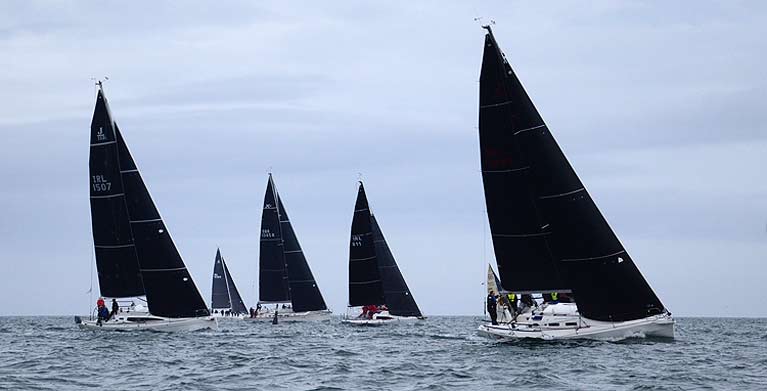 The IRC one fleet on the outer course in the HYC Lambay Race Photo: Conor Lindsay
The IRC one fleet on the outer course in the HYC Lambay Race Photo: Conor Lindsay
In class two, Dave Cullen's Half Tonner Provident CRM beat Equinox R McDonald HYC with Nigel Biggs Checkmate XVIII third.
In class three IRC Dux (A Gore-Grimes) won the X332 sistership battle from Pat Kyne's Maximus with Vincent Gaffney's Alliance II third.
A flat calm foggy morning was what the competitors arrived down to for the annual Regatta and Lambay races. Luckily the wind gods delivered in time for a midday start on both the inshore and offshore courses, with the Howth 17’s setting off a half an hour earlier from the pier to start the long run towards Lambay. The strong ebb tide pushing the boats over the start lines made it challenging for the competitors to time their approaches but the fleets on the inshore course managed to get away cleanly. The fleets on the offshore course had to go into an AP due to a wind shift shortly before the Class 1 start but the delay was brief.
"With 95 boats competing, it was a credit to the course management of the Race Officers"
With 95 boats competing, it was a credit to the course management of the Race Officers, Harry Gallagher and Derek Bothwell afloat and Peter McKenna on the pier, that almost the entire Howth 17 Class and the leading boats from both the inshore and offshore fleets arrived at Lambay around the same time. The requirement was to leave the Island to port, setting up the lottery numbers decision of staying too close the back of the Island, with the risk of losing the wind in the lee of the northern cliffs, or taking the slightly longer off shore option, where some strong gusts made it challenging to hold spinnakers on the tight reach. By the time the boats reached the Taylor Buoy at the north western tip of the Island, the lottery results were known but the long upwind leg back to Howth in the steady 15 to 16 knots, with a few further marks and short reaches to sort out on the way, kept up the hopes of those who found that their choice for the Lambay transit was sub-optimal.
With 95 boats competing, it was a credit to the course management of the Race Officers, Harry Gallagher and Derek Bothwell afloat and Peter McKenna on the pier, that almost the entire Howth 17 Class and the leading boats from both the inshore and offshore fleets arrived at Lambay around the same time.
A great race was had by all with even those who may have misread the course, or indeed found themselves at the start line of the wrong fleet, enjoying a sparkling day afloat and a quick race, with most of the fleets finished within 3 hours. The happy crews enjoyed a great apres-race gathering at Howth Yacht Club, where the war stories were shared, excuses offered, bad luck bemoaned, poor choices ignored and the refreshments enjoyed in the sunshine.
The Lambay Lady was awarded to Steffi Ennis and Windsor Laudan’s timeless Shamrock, Demelza, and the Longerbyn Cup for best Howth YC boat went to Alan Pearson and Alan Blay’s Puppeteer 22, Trick or Treat.
For full results see the HYC website, here.
The evening continued with a great party which included the Champion’s League final, a great meal and dancing late into the night.
In 2020 the Lambay Races will form part of the WAVE Regatta but the Lambay will be raced again in its traditional format in 2021.
Once the ISORA fleet completes its fourth race to Arklow on Saturday, organisers have cooked up a novel and unique race five in the Averycrest sponsored series. Originally, it had been intended that ISORA would join with Howth Yacht Club in the Lambay Race but when the date of that race was brought forward it clashed with the ISORA race to finish in Dublin Port as part of the Dublin Port Riverfest. The solution was 'simple', according to ISORA's Peter Ryan, so they combined the two races into one event and will have two finishes!
There will be a special 'ISORA Class' in the HYC Lambay Race. Boats can enter both the ISORA Class of the Lambay Race and the ISORA Day Race. The start of both races will be provided by Howth YC and the course around Lambay will set by HYC.
The ISORA Class fleet will then proceed to the Lambay race finish off Howth where finish times will be recorded and prizes awarded. However, what is unique about this race is that the ISORA fleet will treat the finish line as a mark on the course and continue on the race toward the 'second finish' in Dublin Port.
The courses for both parts of this unique race will be circulated on the Thursday before the race.
This unique race will test the ability of the racing rules and the use of the YB trackers, but that is the challenge!
Racing at least once a year round the beautiful and unspoilt island of Lambay seven miles north of Howth has been part of the Howth Yacht Club DNA for so long that nobody is 100% certain when this intriguing sporting challenge was first introduced writes W M Nixon.
We know for sure that a cup for the race was first put up in 1899 in the early days of Howth SC, which had been founded in 1895. But it seems the earliest record of results of a race taking place date from 1904. However, there could well have been earlier stagings of it, but as Howth’s sailing functioned in a very laid back and often un-reported style as a contrast to the formality of Dublin Bay’s newspaper-highlighted grand manner of yachting, it’s possible a Lambay Race happened pre-1904.
 Howth 17s Aura and Pauline off the north coast of Lambay. The Howth 17s date from 1898, and have sailed in every Lambay Race. Photo John Deane
Howth 17s Aura and Pauline off the north coast of Lambay. The Howth 17s date from 1898, and have sailed in every Lambay Race. Photo John Deane
Whatever, we know for sure that by 1921 it was a cherished part of the annual calendar, as noted by noted cruiser-racer enthusiast Pat Walsh, who wrote enthusiastically for a sailing journal about the race and his participation in it, with a second place gained in that year’s race.
The Lambay Race has definitely been scheduled every year since, and numbers have waxed and waned and waxed again. For 2017, this classic event is receiving a major boost with sponsorship from the Michael J Wright Hospitality Group, which owns and operates renowned establishments which make Howth such a magnet for discerning visitors.
 HYC Commodore Joe McPeake (left) with Michael Wright of Wright Hospitality Group, whose newly-opened Thai restaurant, Diep in Howth, will be providing a €50 euro voucher for every boat entering the Lambay Races 2017
HYC Commodore Joe McPeake (left) with Michael Wright of Wright Hospitality Group, whose newly-opened Thai restaurant, Diep in Howth, will be providing a €50 euro voucher for every boat entering the Lambay Races 2017
With a return to what used to be a weekend-long event, this year's HYC annual summertime keelboat regatta has been re-formatted to celebrate the traditional weekend that was the Lambay Races & Howth Regatta. The return to a historical format on the June bank holiday weekend (3rd to 5th June 2017) includes racing around Ireland's Eye on Friday night followed by the traditional Lambay Races on Saturday and a cruise-in-company/family day on Sunday.
While the emphasis is on fun sailing, Howth’s on-water racing administration is of international standard. So those who go to the Lambay Weekend for the hottest competition will be well catered for, but so too will other sailors intent mainly on pleasure afloat. As for pleasure ashore, with the Wright Group feeding in its welcome presence (which now includes the new Thai restaurant, Diep, in the group’s flagship pub Findlater’s) the après sailing buzz will be world class.
Afloat, competing classes will be divided into three fleets each with their own race management team. The large offshore fleet will comprise of five 'cruiser classes' along with the Shipman Class, while the inshore fleet includes One-Design fleets such as J80s, Ruffians, E-Boats, Puppeteers and the Squibs. Consolidating the theme of returning to the historical 'weekend' regatta, Howth's indigenous class, the Howth Seventeens will join the 'Classic Classes', starting and finishing off the East Pier. This will be the third year that visiting classic boats will join the event.
The short race on the Friday evening will conclude with a prize-giving in the clubhouse along with a reception for those visitors sailing from further afield and planning to race (or cruise) the following day and on Sunday.
The Lambay Races on Saturday provide a unique opportunity and challenge for racing teams to compete in what might at first glance appear to be a relatively straightforward windward-leeward race, but encompassing a variety of extras including coastal navigation, tidal considerations, shoreline rock-hopping and sailing in a variety of weather conditions on the different points of the course.
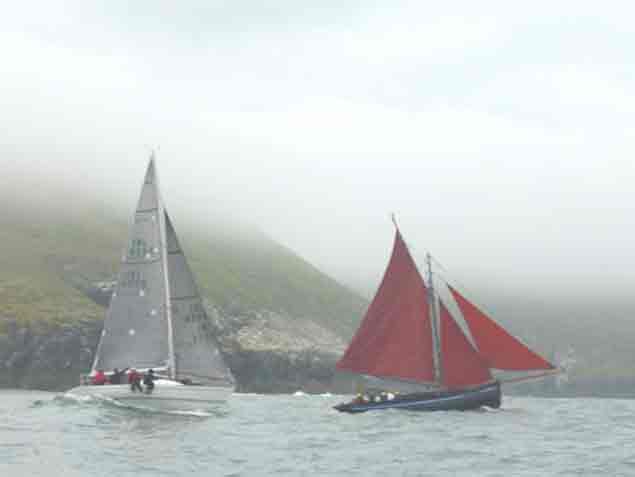 The Lambay Race caters for all sorts. This is the former World Half Ton Champion King One and the traditional Galway Hooker Naomh Cronan rounding Lambay in a patch of mist which had cleared to strong sunshine by race’s end. Photo W M Nixon
The Lambay Race caters for all sorts. This is the former World Half Ton Champion King One and the traditional Galway Hooker Naomh Cronan rounding Lambay in a patch of mist which had cleared to strong sunshine by race’s end. Photo W M Nixon
Speaking at the launch of the sponsorship announcement, HYC Commodore Joe McPeake said: 'The club is delighted to have the partnership with Michael and his team, and there is no doubt that the involvement of the Michael J Wright Hospitality Group will add a significant extra dimension to this ever-popular regatta.'
The club is encouraging everyone to get afloat that weekend - racing or not, there will be something for members and visitors of all ages to enjoy. A massive entertainment and hospitality programme is being assembled and it will include an event reception on Friday evening, live bands after racing on Saturday with themed bars and 'Diep' catering providing a lively party through to prizegiving and after the Lambay Dinner, more live music and dance into the small hours.
Sunday's cruise around Ireland's Eye and a family day ashore will no doubt be aided by the 'lay-day' that the Bank Holiday Monday will provide. And every boat that enters the Regatta also gets a €50 voucher for the newly-opened Diep restaurant, which makes the Lambay Weekend 2017 unique. Enter online here
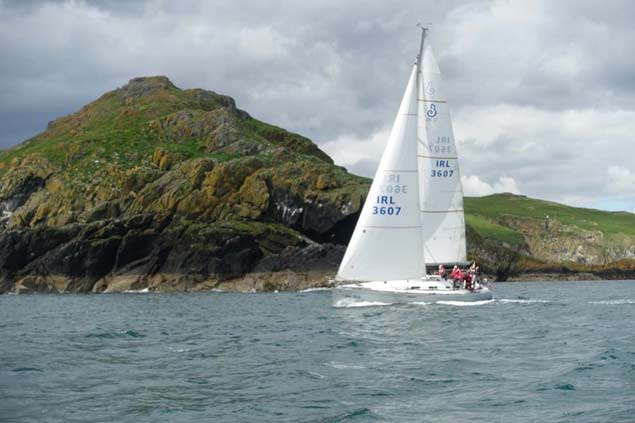 “Lambay weather” as everyone remembers it. Photo HYC
“Lambay weather” as everyone remembers it. Photo HYC
Howth YC's Lambay Race Banking On Saturday Sunshine
#LambayRace - Howth Yacht Club’s annual Lambay Race, which goes back at least as far as 1904 and maybe even further, is set to make the best of the current spell of summer weather this Saturday 4 June, writes WM Nixon.
A comprehensive programme with sponsorship from Davy Group will see upwards of a hundred keelboats of all shapes and sizes being catered for in a variety of courses all of which take in the historic island.
Despite being within a dozen miles of Dublin city centre, Lambay continues to have one of the most perfectly unspoilt coastlines anywhere in Ireland.
For the classic Howth 17s of 1898 vintage, the traditional course will be provided, starting from a shore line at the end of the East Pier, and sailing through the sound inside Ireland’s Eye before going on north to round Lambay. A similar start and course will also be provided for other classics and old gaffers.
For more modern boats, racing will be provided in Howth’s unrivalled main sailing area between Ireland’s Eye and Lambay, but although proper windward starts and several angles of sailing will be provided on multiple legs, here too the fleet will at some stage round Lambay.
The race schedule – which sees the first pier starts at 11.30am, and the Committee Boat starts north of Ireland’s Eye from 12 noon onwards – will be shaped to have the fleet finished well within time to enjoy a very full hospitality programme including barbecues, live music and entertainment far into the night.
And at some stage the famous Lambay Lady trophy will be awarded to the winning boat which has the largest margin between her time and that of the second boat in her class.
Howth's Lambay Race Cancelled Due to Strong Winds
#hyc – Disappointment in Howth Yacht Club this afternoon after the cancellation of its eagerly anticipated Lambay race was scrubbed because of strong westerly winds. The Howth fixture is the second major sailing fixture in the Capital's waters to fall victim to today's weather. Earlier, Dublin Bay Sailing Club scrubbed club racing for an estimated 200 boats off Dun Laoghaire.
Howth Yacht Club Predicts Big Lambay Race Turnout
#lambay – Howth Yacht Club is forecasting a bumper turnout for its Lambay Race. With less than three weeks to go before Howth Yacht Club's annual regatta, the Lambay Races are already attracting strong entries and event chairman James Markey says that this year's race around Fingal's historic island promises to be one of the largest attended in recent years. In addition to the usual amount of visitors (normally accounting for a third of all competing yachts), the extra fleet of 'old gaffers' and the favourable timing of this year's regatta, just a week before the Dun Laoghaire to Dingle Race, will also be attractive to many more coastal and offshore sailors.
Howth Yacht Club Sign Up New Lambay Race Sponsor
#hyc – With a little more than six weeks to go before the longstanding annual keelboat regatta, Howth Yacht Club has announced Davy Group as sponsors of the event. The Lambay Races affords skippers and crew of cruisers and one-design keelboats the opportunity of competing in a 'testing' coastal yacht race which is traditionally run on the Saturday after the June Bank Holiday, meaning that the event will be run on June 6th this year.
Davy Private Clients' Graham Cawley said of the announcement: 'Davy has been working withclients since 1926 helping them to plan for the future and navigate markets whatever the conditions. We are delighted to support Howth Yacht Club and to be associated with the Lambay Races - a long standing, much loved regatta, revered by sailors up and down the coast.'
In addition to the 5 cruiser classes and 6 one-design classes competing, event organiser James Markey has also included a traditional course for the 'Old Gaffers', following their successful and most welcome inclusion last year. However, brown sails and the smell of turf won't distract from the serious racing business within all of the classes, after which the infamous party will commence ashore.




























